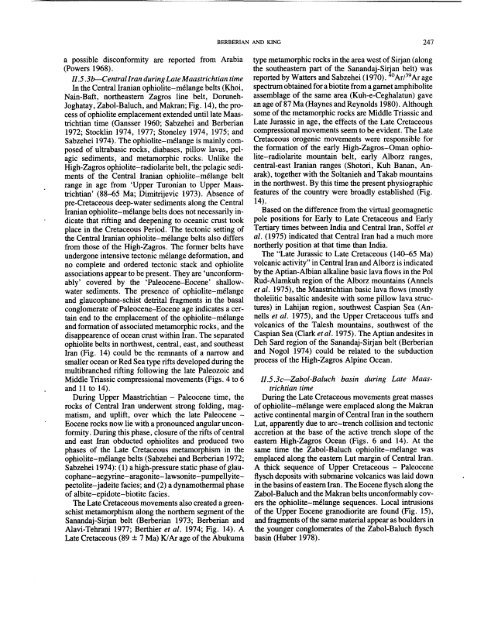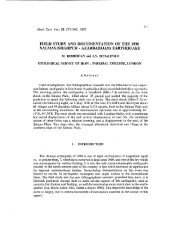PDF COPY - Manuel berberian
PDF COPY - Manuel berberian
PDF COPY - Manuel berberian
Create successful ePaper yourself
Turn your PDF publications into a flip-book with our unique Google optimized e-Paper software.
a possible disconformity are reported from Arabia<br />
(Powers 1968).<br />
H.5.3b~Central Iran during Late Maastrichtian time<br />
In the Central Iranian ophiolite-m61ange belts (Khoi,<br />
Nain-Baft, northeastern Zagros line belt, Doruneh-<br />
Joghatay, Zabol-Baluch, and Makran; Fig. 14), the process<br />
of ophiolite emplacement extended until late Maastrichtian<br />
time (Gansser 1960; Sabzehei and Berberian<br />
1972; Stocklin 1974, 1977; Stoneley 1974, 1975; and<br />
Sabzehei 1974). The ophiolite-m61ange is mainly composed<br />
of ultrabasic rocks, diabases, pillow lavas, pelagic<br />
sediments, and metamorphic rocks. Unlike the<br />
High-Zagros ophiolite-radiolarite belt, the pelagic sediments<br />
of the Central Iranian ophiolite-m61ange belt<br />
range in age from ’Upper Turonian to Upper Maastdchtian’<br />
(88-65 Ma; Dimitrijevic 1973). Absence<br />
pre-Cretaceous deep-water sediments along the Central<br />
Iranian ophiolite-m61ange belts does not necessarily indicate<br />
that rifting and deepening to oceanic crust took<br />
place in the Cretaceous Period. The tectonic setting of<br />
the Central Iranian ophiolite-m61ange belts also differs<br />
from those of the High-Zagros. The former belts have<br />
undergone intensive tectonic m61ange deformation, and<br />
no complete and ordered tectonic stack and ophiolite<br />
associations appear to be present. They are ’unconformably’<br />
covered by the ’Paleocene-Eocene’ shallowwater<br />
sediments. The presence of ophiolite-m61ange<br />
and glaucophane-schist detrital fragments in the basal<br />
conglomerate of Paleocene-Eocene age indicates a certain<br />
end to the emplacement of the ophiolite-m61ange<br />
and formation of associated metamorphic rocks, and the<br />
disappearence of ocean crust within Iran. The separated<br />
ophiolite belts in northwest, central, east, and southeast<br />
Iran (Fig. 14) could be the remnants of a narrow and<br />
smaller ocean or Red Sea type rifts developed during the<br />
multibranched rifting following the late Paleozoic and<br />
Middle Triassic compressional movements (Figs. 4 to<br />
and 11 to 14).<br />
During Upper Maastrichtian - Paleocene time, the<br />
rocks of Central Iran underwent strong folding, magmatism,<br />
and uplift, over which the late Paleocene -<br />
Eocene rocks now lie with a pronounced angular unconformity.<br />
During this phase, closure of the rifts of central<br />
and east Iran obducted ophiolites and produced two<br />
phases of the Late Cretaceous metamorphism in the<br />
ophiolite-m61ange belts (Sabzehei and Berberian 1972;<br />
S abzehei 1974): (1) a high-pressure static phase of glaucophane-aegyrine-aragonite-<br />
lawsonite-pumpellyitepectolite-jadeite<br />
facies; and (2) a dynamothermal phase<br />
of albite-epidote-biotite facies.<br />
The Late Cretaceous movements also created a greenschist<br />
metamorphism along the northern segment of the<br />
Sanandaj-Sirjan belt (Berberian 1973; Berberian and<br />
Alavi-Tehrani 1977; Berthier et al. 1974; Fig. 14).<br />
Late Cretaceous (89 + 7 Ma) K/Ar age of the Abukuma<br />
BERBERIANANDKING 247<br />
type metamorphic rocks in the area west of Sirjan (along<br />
the southeastern part of the Sanandaj-Sirjan belt) was<br />
reported by Watters and Sabzehei (1970). 4°Ar/39Ar age<br />
specmam obtained for a biotite from a garnet amphibolite<br />
assemblage of the same area (Kuh-e-Ceghalatun) gave<br />
an age of 87 Ma (Haynes and Reynolds 1980). Although<br />
some of the metamorphic rocks are Middle Triassic and<br />
Late Jurassic in age, the effects of the Late Cretaceous<br />
compressional movementseem to be evident. The Late<br />
Cretaceous orogenic movements were responsible for<br />
the formation of the early High-Zagros-Oman ophiolite-radiolarite<br />
mountain belt, early Alborz ranges,<br />
central-east Iranian ranges (Shotori, Kuh Banan, Anarak),<br />
together with the Soltanieh and Takab mountains<br />
in the northwest. By this time the present physiographic<br />
features of the country were broadly established (Fig.<br />
14).<br />
Based on the difference from the virtual geomagnetic<br />
pole positions for Early to Late Cretaceous and Early<br />
Tertiary times between India and Central Iran, Soffel et<br />
al. (1975) indicated that Central Iran had a much more<br />
northerly position at that time than India.<br />
The "Late Jurassic to Late Cretaceous (140-65 Ma)<br />
volcanic activity" in Central Iran and Alborz is indicated<br />
by the Aptian-Albian alkaline basic lava flows in the Pol<br />
Rud-Alarnkuh region of the Alborz mountains (Annels<br />
et al. 1975), the Maastrichtian basic lava flows (mostly<br />
tholeiitic basaltic andesite with some pillow lava structures)<br />
in Lahijan region, southwest Caspian Sea (Annells<br />
et al. 1975), and the Upper Cretaceous tuffs and<br />
volcanics of the Talesh mountains, southwest of the<br />
Caspian Sea (Clark etal. 1975). The Aptian andesites in<br />
Deh Sard region of the Sanandaj-Sirjan belt (Berberian<br />
and Nogol 1974) could be related to the subduction<br />
process of the High-Zagros Alpine Ocean.<br />
H.5.3c--Zabol-Baluch basin during Late Maastrichtian<br />
time<br />
During the Late Cretaceous movements great masses<br />
of ophiolite-m61ange were emplaced along the Makran<br />
active continental margin of Central Iran in the southern<br />
Lut, apparently due to arc-trench collision and tectonic<br />
accretion at the base of the active trench slope of the<br />
eastern High-Zagros Ocean (Figs. 6 and 14). At the<br />
same time the Zabol-Baluch ophiolite-m61ange was<br />
emplaced along the eastern Lut margin of Central Iran.<br />
A thick sequence of Upper Cretaceous - Paleocene<br />
flysch deposits with submarine volcanics was laid down<br />
in the basins of eastern Iran. The Eocene flysch along the<br />
Zabol-Baluch and the Makran belts unconformably covers<br />
the ophiolite-m61ange sequences. Local intrusions<br />
of the Upper Eocene granodiorite are found (Fig. 15),<br />
and fragments of the same material appear as boulders in<br />
the younger conglomerates of the Zabol-Baluch flysch<br />
basin (Huber 1978).







